Outlook.com
| File:Outlook.com inbox and Skype sidebar view.png Outlook Mail inbox in Outlook.com with Skype sidebar open | |
Type of site | Webmail, contacts, tasks, and calendaring |
|---|---|
| Owner | Microsoft |
| URL | outlook |
| Commercial | Yes |
| Registration | Required |
| Users | 400 million[1] |
| Launched | July 4, 1996 (as Hotmail) July 31, 2012 (as Outlook.com) |
| Current status | Online |
Content license | Proprietary |
Outlook.com is a web-based suite of webmail, contacts, tasks, and calendaring services from Microsoft. One of the world's first webmail services,[3] it was founded in 1996 as Hotmail (stylized as HoTMaiL) by Sabeer Bhatia and Jack Smith in Mountain View, California, and headquartered in Sunnyvale.[4][5] Hotmail was acquired by Microsoft in 1997 for an estimated $400 million and launched as MSN Hotmail, later rebranded to Windows Live Hotmail as part of the Windows Live suite of products.[1][6] Microsoft released the final version of Hotmail in October 2011, available in 36 languages.[7][8][9] It was replaced by Outlook.com in 2013.
Outlook.com follows Microsoft's Metro design language, closely mimicking the interface of Microsoft Outlook. It also features unlimited storage, a calendar, contacts management, Ajax, and close integration with OneDrive, Office Online and Skype.[10] In May 2015, it was announced that a preview of the new Outlook.com will move it to the Office 365 infrastructure.[11] Microsoft concluded its preview stage in February 2016, when it began to roll out the new version to users' accounts, beginning with North America.[12] As of 2015, Outlook.com had 400 million active users.[1][13]
History
Launch of Hotmail
Hotmail service was founded by Sabeer Bhatia and Jack Smith, and was one of the first webmail services on the Internet along with Four11's RocketMail (later Yahoo! Mail). It was commercially launched on July 4, 1996, symbolizing "freedom" from ISP-based email[14] and the ability to access a user's inbox from anywhere in the world. The name "Hotmail" was chosen out of many possibilities ending in "-mail" as it included the letters HTML, the markup language used to create web pages (to emphasize this, the original type casing was "HoTMaiL"). The limit for free storage was 2 MB.[5] Hotmail was initially backed by venture capital firm Draper Fisher Jurvetson. By December 1997, it reported more than 8.5 million subscribers.[15] Hotmail initially ran under Solaris for mail services and Apache on FreeBSD for web services, before being partly converted to Microsoft products,[16][17] using Windows Services for UNIX in the migration path.[18]
MSN Hotmail
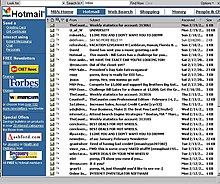
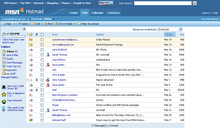
Hotmail was sold to Microsoft in December 1997 for a reported $400 million, and it joined the MSN group of services.[19] Hotmail quickly gained in popularity as it was localized for different markets around the globe, and became the world's largest webmail service with more than 30 million active members reported by February 1999.[20] Hotmail originally ran on a mixture of FreeBSD and Solaris operating systems.[21] A project was started to move Hotmail to Windows 2000. In June 2001, Microsoft claimed this had been completed; a few days later they retracted and admitted that the DNS functions of the Hotmail system were still reliant on FreeBSD. In 2002 Hotmail still ran its infrastructure on UNIX servers, with only the front-end converted to Windows 2000.[22] Later development saw the service tied with Microsoft's web authentication scheme, Microsoft Passport (now Microsoft account), and integration with Microsoft's instant messaging and social networking programs, MSN Messenger and MSN Spaces (now Windows Live Messenger and Windows Live Spaces, respectively).
Security issues
In 1999, hackers revealed a security flaw in Hotmail that permitted anybody to log in to any Hotmail account using the password 'eh'. At the time it was called "the most widespread security incident in the history of the Web".[23] In 2001, the Hotmail service was compromised again by computer hackers who discovered that anyone could log in to their Hotmail account and then pull messages from any other Hotmail account by crafting a URL with the second account's username and a valid message number. It was such a simple attack that by the time the patch was made, dozens of newspapers and hundreds of web sites published exact descriptions allowing tens of thousands of hackers to run rampant across Hotmail. The exploitable vulnerability exposed millions of accounts to tampering between August 7, 2001 and August 31, 2001.[24][25]
Competition
In 2004, Google announced its own mail service, Gmail. Featuring greater storage space, speed, and interface flexibility, this new competitor spurred a wave of innovation in webmail.[26] The main industry heavyweights – Hotmail and Yahoo! Mail – introduced upgraded versions of their email services with greater speed, security, and advanced features.[27][28]
Windows Live Hotmail
Microsoft's new email system was announced on November 1, 2005, under the codename "Kahuna", and a beta version was released to a few thousand testers. Other webmail enthusiasts also wanting to try the beta version could request an invitation granting access. The new service was built from scratch and emphasized three main concepts of being "faster, simpler, and safer". New versions of the beta service were rolled out over the development period, and by the end of 2006 the number of beta testers had reached the millions.[29]
The Hotmail brand was planned to be phased-out when Microsoft announced that the new mail system would be called Windows Live Mail, but the developers soon backtracked after beta-testers were confused with the name change and preferred the already well-known Hotmail name, and decided on Windows Live Hotmail. After a period of beta testing, it was officially released to new and existing users in the Netherlands on November 9, 2006, as a pilot market. Development of the beta was finished in April 2007, Windows Live Hotmail was released to new registrations on May 7, 2007, as the 260 million MSN Hotmail accounts worldwide gained access to the new system. The old MSN Hotmail interface was accessible only by users who registered before the Windows Live Hotmail release date and had not chosen to update to the new service. The roll-out to all existing users was completed in October 2007.
Windows Live Hotmail was awarded PC Magazine's Editor's Choice Award in February 2007,[30] March 2007,[31] and February 2011.[32]
In 2008 it was announced that the service would be updated with focus on improving the speed, increasing the storage space, better user experience and usability features, and that sign-in and email access speeds would be up to 70 percent faster.[33] The classic and full versions of Windows Live Hotmail were combined in the new release. As a result of user feedback, Hotmail was updated so that scrolling works for users who have the reading pane turned off. It was also expected that Hotmail team would be moving the advertisement from the top of page to the side, adding more themes, increasing the number of messages on each page and adding the ability to send instant messages from the user's inbox in future releases.[34]
Support for Firefox in the upgraded Windows Live Hotmail took a few months to complete. By 2009, support for Google Chrome was still incomplete, prompting the Chrome developers to temporarily ship a browser that employed user agent spoofing when making requests to the Windows Live site.[35]
As part of the update, Microsoft also added integrated capability for instant messaging with contacts on the Windows Live Messenger service. The feature was the realization of a project that began as "Windows Live Web Messenger" in 2007, a replacement for the outdated "MSN Web Messenger" service that was first launched in August 2004. It was noted that the original "Windows Live Web Messenger" featured tabbed conversations in a "conversation workspace", however since its integration with Hotmail this has been removed.[36][37]
Microsoft's search engine Bing was integrated into Hotmail in 2009 through the introduction of a "Quick Add" feature, allowing users to add search results from Bing into emails. These include images, maps and business listings.[38]
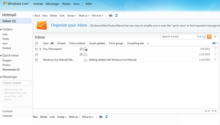
On May 18, 2010, Microsoft unveiled the "Wave 4" update of Hotmail, which offered features such as 1-click filters, active views, inbox sweeping, and 10 GB space for photos, Microsoft Office documents, and attachments.[39] It also included integration with Windows Live SkyDrive and Windows Live Office, a free version of Microsoft's Office Web Apps suite. The new version began its gradual release to all Hotmail users on June 15, 2010[40] and was completely rolled out on August 3, 2010.[41] Exchange ActiveSync support was enabled to all Hotmail users on August 30, 2010, allowing users to sync their mail, contacts, calendar and tasks to their mobile devices that supports the protocol.[42] Addition of full-session SSL was released on November 9, 2010.
Throughout 2011, Microsoft added several new features to Hotmail, such as aliases[43] and speed improvements.[44] In October 2011, Microsoft unveiled a "re-invented Hotmail", and added many new features such as Instant Actions, scheduled Sweep, and Categories[45][46][47] and this update began fully rolling out on November 9, 2011.[48] This update also made SSL enabled by default on all accounts.
Transition to Outlook.com

Outlook.com was first introduced on July 31, 2012 when its beta version was made available to the general public. Existing Hotmail customers could freely upgrade to the preview version of Outlook.com and downgrade back.[49]
Outlook.com graduated preview stage on 18 February 2013. According to Microsoft, the upgrade was deployed on April 3, 2013; the user kept their existing Hotmail accounts and received the option of having an @outlook.com email address. By May 2013, Outlook.com had 400 million active users.[50]
Transition to a new infrastructure
In May 2015, Microsoft announced it would move the service over to what it described as an Office 365-based infrastructure.[51] This was followed in June 2015 by the introduction through an opt-in preview of new features, including new calendar layout options, a filtering service called "Clutter" and new theme designs.[52] Microsoft also introduced the ability for third-party providers such as PayPal and Evernote to include add-ins into the service.[53] Additionally, contact suggestions and updates from emails such as flight reservations are due to be introduced to Office 365 subscribers' accounts and Outlook.com users' from January and March 2016 respectively.[54] With the upgrade, users will no longer be able to use the Windows Live Mail 2012 client, and are encouraged to view Outlook.com through a browser, through the Mail app, or through the Outlook client.[55]
Although DeltaSync has been discontinued as of June 30, 2016, Microsoft's Windows Live Mail 2011 and 2012 will continue to work with Hotmail e-mail accounts, by using IMAP (or, less effectively, POP) in place of DeltaSync.[56][57]
Features

Similar to other major webmail services, Outlook.com uses Ajax programming techniques and supports later versions of Internet Explorer, Firefox, Safari, and Google Chrome. Some of its features include keyboard controls giving the ability to navigate around the page without using the mouse, the ability to search the user's messages including structured query syntax such as "from:ebay", message filters, folder-based organization of messages, auto-completion of contact addresses when composing, contact grouping, importing and exporting of contacts as CSV files, rich text formatting, rich text signatures, spam filtering and virus scanning, support for multiple addresses, and different language versions.
One example of a feature no longer present is the ability to create custom domain names.[58]
Security and privacy
Outlook.com has promised to respect user's privacy, specifically targeting Gmail's privacy practices.[59] Outlook.com does not scan emails or attachments for advertising information and personal conversations are ad-free entirely.[60][61]
In March 2014, when former Microsoft employee Alex Kibkalo was arrested for his involvement in 2012 leaking of Microsoft's trade secrets, Microsoft came under criticism for having accessed the email inbox of his French accomplice.[62][63] Critics claim these actions violate privacy laws[64][65] as well as Microsoft's own promises with regards to users' personal information,[66] while others have pointed out that such access is permitted under Microsoft's privacy policies in order to "protect the rights or property of Microsoft",[67][68] that it was necessary in order to prevent a crime intended to have inflicted billions of dollars of damage, and that such action on Microsoft part is unprecedented in 18 years.[69] In response to the criticism, Microsoft has announced that it would no longer access private account information themselves in such cases, but would instead hand the investigation over to law enforcement agencies.[70][71]
Outlook.com uses DMARC specifications to provide better security for message transmission and Extended Validation Certificate to secure the user's connection with Outlook.com.[72] On April 17, 2013, Microsoft added two step verification to Microsoft accounts, thereby by extension to Outlook.com.[73]
Outlook also allows for a single-use code to be used instead of a user's password when signing into a Microsoft account. Each code can be used only one time, but one can be requested whenever needed. If a user is signing in on a public computer—such as at the library or school—using a single-use code helps keep account information secure. The single-use code is sent to the user when requested during login.[74]
Active View
Outlook.com's Active View allows users to interact directly with contents and functionality within their email message. For example, any photo attachments can be previewed directly using Active View. In addition, Outlook.com provides a partner platform which allows contents and functionality from various websites and services such as YouTube, Flickr, LinkedIn, and the United States Postal Service to be viewed directly within the email message. For example, users may view the YouTube video within Outlook.com when a user receives an email which contains a link to the video. Other Active View features include tracking of real time shipping status from United States Postal Service and performing social networking actions on LinkedIn or other social networking sites directly from within the email message.
Calendar
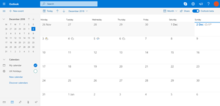
Outlook's time-management web application was first released on January 14, 2008 as Windows Live Calendar, and was updated to the "Wave 4" release on June 7, 2010. It was updated with Microsoft's Metro design in a phased roll-out to users from April 2, 2013.[75]
Calendar features a similar interface to desktop calendar applications such as Windows Calendar, and supports iCalendar files for users to import calendar entries into their calendars. It uses Ajax technology which enables users to view, add and drag-and-drop calendar events from one date to another without reloading the page, and features daily, weekly, monthly and agenda view modes. It also features a to-do list function for users to keep track of their tasks to be completed.
Calendar events are stored online and can be viewed from any location. Multiple calendars can be created and shared, allowing different levels of permissions for each user.
People
Outlook's contacts management service was originally known as Windows Live Contacts and before that, Windows Live People. It provides users with access to their contacts' profiles and information, allowing them to share different information with different groups of people. Besides an address book, People also provides integrated services with social media, such as Facebook and Twitter.[76] The service was rebranded to its current name in 2012, introducing a new interface based on the Metro design language that had already been introduced with Outlook.com.
Contacts are automatically updated in real-time, and the service allows for the removal of duplicated contact entries when imported with Profile. Users can also set limits on what parts of their contact details can be seen by others.
Office Online integration
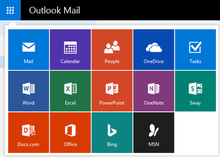
Outlook.com integrates with Office Online to allow viewing and editing of Microsoft Word, Excel and PowerPoint documents that are attached to the email messages. Users can directly open attached Office documents within the web browser, and save them into their OneDrive. Users can also perform edits to any received Office documents, and directly reply to the sender with the edited version of the document. In addition, users may also send up to 25 GB of Office documents (up to 50 MB each) using Outlook.com by uploading these documents onto OneDrive, and share these documents with other users for viewing or collaboration. Users can also save emails to OneNote.[77]
Skype integration
A preview version of Skype for Outlook.com started rolling out in the UK on April 30, 2013. This feature allows users to make a Skype video call within Outlook.com without using the Skype desktop client.[78]
Sweep
Outlook.com offers a "virtual broom" which allow users to delete or move large amounts of emails into specified folders based on the sender's information. Once a "sweep" is performed, the user may choose to configure Outlook.com to remember the sweep settings and perform the same move or delete actions for any future emails. Users may also set up custom message rules based on the sender's or recipient's information, the subject of the email, or attachments to the email. There is also an option to delete/move messages that are older than a specified amount of days, or only keep the latest message from a sender.
Quick views and one-click filters
Quick views allow users to filter all emails (in all folders) by document attachments, photo attachments, flagged messages, or shipping updates. One-click filters allow users to filter the inbox (or specific folder) based on whether or not the email message is unread, from the People service list, group mailing lists, or from a social networking website. Categories appear under quick views for ease of access.
Aliases
Users can create additional, unique email addresses, called aliases, for their Microsoft account. As of April 17, 2013, users can now sign in with any alias and create up to 10 aliases per year for a total of up to 10 addresses. For a given account, all aliases uses the same inbox, contact list, and account settings—including password—as the primary address. Once an alias is set up, users can choose to have all email sent to that address go to the inbox, or to a different folder.[79] Emails sent from an alias do not reveal to recipients that they come from an account with other addresses.
Mobile applications
Microsoft has released client applications for Android and iOS, allowing users to access their inboxes and send new messages. The apps were formerly known as Acompli, which was acquired by Microsoft in December 2014, and were rebranded as Outlook Mobile in January 2015
Mail client access
Outlook.com supports email clients connecting through the following protocols, listed in chronological order:
- WebDAV was used by Outlook Express but was discontinued on September 1, 2009.[80][81]
- DeltaSync was used by Microsoft Outlook Hotmail Connector, a free plug-in for Microsoft Outlook 2003, 2007 or 2010. Using the Outlook connector, users can freely access email messages, contacts, and calendars in any Outlook.com account, though access to tasks and notes requires a premium subscription. Another alternative for users is to use the Windows Live Mail desktop client, which had built-in support for Hotmail.[82]
- Post Office Protocol version 3 (POP3) access has been made available for all Hotmail accounts as part of the "Wave 3" release, adding support to access Hotmail from any email client that supported this protocol.[83]
- Exchange ActiveSync (EAS) support was added as part of the Hotmail "Wave 4" release, allowing users to synchronise not just their email, but also their contacts and calendar on any device that supports EAS.[84]
- On September 12, 2013, Microsoft added support for Internet Message Access Protocol (IMAP) and OAuth.[85][86] IMAP enables users to continue to access Hotmail from any email client that supports this protocol, including Windows Live Mail 2011 and 2012, following the discontinuance of DeltaSync.[87][88]
Controversy
Popularity with spammers
Like many free Webmail services, Hotmail was often used by spammers for illicit purposes such as junk or chain mailing and unwanted marketing, due to wide availability, service popularity, and ease of registration of new accounts.[89] Hotmail amended its service agreement stating that any account engaging in these activities would be terminated without warning.[90][91]
Requests for contact details
The ability to associate Outlook.com accounts with mobile phones or other email addresses was initially advertised as an optional feature.[92] However, an update in 2013 required many users to associate their accounts before the website would allow them to log in - a refusal which could be sidestepped by using an app, such as Windows Live Mail 2011 or 2012, to access the account instead of a web browser (and it remains possible to "associate" an account with a one-use, or otherwise 'disposable', e-mail address).[93] Some users also saw messages that their accounts would expire if they continued to use them anonymously.
US government surveillance
According to theguardian.com, several top-secret internal National Security Agency (NSA) newsletters indicate that Microsoft has allowed NSA to access chats and emails on Outlook.com, and implemented a bypass of its advertised encryption in order to facilitate government access.[94]
- One newsletter entry dated December 26, 2012, shows that Microsoft had "developed a surveillance capability to deal" with the interception of encrypted chats on Outlook.com, within five months after the service went into public testing.[94]
- Another entry states that "for Prism collection against Hotmail, Live, and Outlook.com emails will be unaffected because Prism collects this data prior to encryption".[94]
In response to the report, Microsoft stated, among other things, that "when we upgrade or update products we aren't absolved from the need to comply with existing or future lawful demands" and that "there are aspects of this debate that we wish we were able to discuss more freely".[94]
See also
References
- ^ a b c Law, David (July 18, 2016). "Outlook.com leaves preview as the world's fastest growing email service going from 0 to 60 million in just 6 months". Microsoft News. Microsoft. Retrieved February 19, 2013.
- ^ "Outlook.com Site Info". Alexa Internet. Retrieved October 11, 2016.
- ^ "The "Hotmail" Evolution". TechPluto. Accu-rate Media. June 22, 2009. Retrieved October 26, 2010.
- ^ "4th Network Hotels Get Wired with Hotmail E-mail Service and High Speed Internet Access; Hotmail and 4th Network Ink Agreement to Keep Business Travelers Connected". Business Wire. October 21, 1996. Retrieved August 1, 2013.
- ^ a b "A short history of Hotmail". Inside Windows Live. Microsoft. January 6, 2010. Retrieved October 26, 2010.
- ^ Thurrott, Paul (July 31, 2012). "Outlook.com Mail: Microsoft Reimagines Webmail". Supersite for Windows. Penton Media. Retrieved August 1, 2012.
- ^ "Hotmail introduces hacking alert system". People's Daily Online. July 15, 2011. Archived from the original on June 27, 2012. Retrieved August 1, 2013.
- ^ "Windows Live Hotmail Launches Worldwide in 36 Languages". IT News Online. May 7, 2007. Archived from the original on March 5, 2008. Retrieved October 26, 2010.
{{cite web}}:|archive-date=/|archive-url=timestamp mismatch; May 3, 2008 suggested (help) - ^ Wilhelm, Alex (October 3, 2011). "Microsoft announces massive Hotmail update to better combat Gmail". The Next Web. Retrieved June 19, 2012.
- ^ "Windows Live Hotmail Fact Sheet". Microsoft. May 2007. Retrieved April 30, 2011.
- ^ Team, Outlook. "New ways to get more done in Outlook.com". Office Blogs. Retrieved December 6, 2015.
- ^ Hachman, Mark (February 17, 2016). "What you need to know about Outlook.com as Microsoft brings it out of preview". PC World. Retrieved February 22, 2016.
- ^ Wilhelm, Alex (May 13, 2014). "Outlook.com Bests Gmail's Filters With A New Inbox Automation System". Tech Crunch. Retrieved December 26, 2015.
- ^ "Sabeer Bhatiya : The founder of "Hotmail.com"". 4to40.com. Archived from the original on February 10, 2007. Retrieved November 19, 2009.
- ^ "Hotmail, Microsoft talk deals". CNET. CBS Interactive. December 5, 1997. Retrieved March 23, 2007.
- ^ "Solaris calls Hotmail shots for Microsoft". VNU Business Publications. April 22, 1998. Retrieved January 31, 2012.
- ^ Magee, Mike (December 24, 2002). "Microsoft uses Solaris servers for Hotmail shock". Retrieved August 1, 2013.
- ^ "Planning Guide for Migrating Microsoft Hotmail from FreeBSD to Microsoft Windows 2000 Technical Case Study". Microsoft TechNet. Retrieved June 23, 2014.
- ^ Pelline, Jeff (January 3, 1998). "Microsoft Buys Hotmail". CNET. CBS Interactive. Retrieved June 22, 2007.
- ^ "MSN Hotmail: From Zero to 30 Million Members in 30 Months". Microsoft. February 8, 1999. Archived from the original on May 14, 2007. Retrieved March 23, 2007.
- ^ "Converting a UNIX.COM site to Windows". Microsoft Secrets. Security Office. Archived from the original on November 8, 2007. Retrieved November 3, 2007.
- ^ Orlowski, Andrew (December 12, 2001). "Microsoft Hotmail still runs on U**x". The Register. Situation Publishing. Retrieved June 14, 2013.
- ^ Glave, James (August 30, 1999). "Hotmail Hackers: 'We Did It'". Wired. Condé Nast. Retrieved November 3, 2007.
- ^ Greene, Thomas C (August 20, 2001). "Hacking Hotmail made easy". The Register. Situation Publishing. Retrieved September 17, 2008.
- ^ Knight, Will (August 21, 2001). "Hotmail hole leaves email open to view". New Scientist. Retrieved March 1, 2011.
- ^ Paul, Ian (May 3, 2013). "Outlook.com vs. Gmail: What Microsoft is Still Missing". PC World. IDG. Retrieved September 8, 2013.
- ^ Cifuentes, Jamie. "Farewell Hotmail: Microsoft Completes Outlook.com Upgrade". pcmag. Retrieved November 22, 2014.
- ^ Constine, Josh. "Yahoo Shuts Down Mail Classic, Forces Switch To New Version That Scans Your Emails To Target Ads". techcrunch. Retrieved November 22, 2014.
- ^ "M7 new code shipping soon – not yet here!". Microsoft. July 17, 2006. Retrieved March 21, 2007.
- ^ Janowski, Davis D. (January 31, 2007). "Buying Guide: Web E-Mail Clients". PC Magazine. Ziff Davis. Retrieved March 21, 2007.
- ^ Janowski, Davis D. "Windows Live Hotmail (beta)". PC Magazine. Ziff Davis. Retrieved April 10, 2007.
- ^ Muchmore, Michael. "Windows Live Hotmail 2011". PC Magazine. Ziff Davis. Retrieved September 29, 2011.
- ^ "Coming Soon". Microsoft. Archived from the original on September 14, 2008. Retrieved July 24, 2010.
- ^ "Hotmail: Classic scrolling is back, and more updates". Windows Live Wire. Microsoft. December 18, 2008. Retrieved August 1, 2013.
- ^ Shankland, Stephen (January 30, 2009). "Google fakes out Hotmail for Chrome support". CNET. Retrieved February 4, 2015.
- ^ "Web IM in Hotmail!". Windows Live Wire. Microsoft. April 20, 2009. Retrieved July 24, 2010.
- ^ "Windows Live Web Messenger goes into dogfood". LiveSide.net. September 19, 2007. Retrieved July 24, 2010.
- ^ Arrington, Michael (July 9, 2009). "Bing Comes To Hotmail". TechCrunch. AOL. Retrieved March 23, 2007.
- ^ Craddock, Dick (May 17, 2010). "Re-inventing Windows Live Hotmail – the next generation of personal email". Inside Windows Live. Microsoft. Retrieved May 18, 2010.
- ^ Schackwitz, Mike (July 28, 2010). "Hotmail rollout picks up steam!". Inside Windows Live. Microsoft. Retrieved July 29, 2010.
- ^ Schackwitz, Mike (August 3, 2010). "The new Hotmail is now available to everyone". Inside Windows Live. Microsoft. Retrieved August 8, 2010.
- ^ Craddock, Dick (August 30, 2010). "Hotmail now supports push email, calendar, and contacts with Exchange ActiveSync". Inside Windows Live. Microsoft. Retrieved August 30, 2010.
- ^ Mehta, Dharmesh (February 3, 2011). "Hotmail delivers aliases to help you manage and secure your email account". Inside Windows Live. Microsoft. Retrieved November 6, 2011.
- ^ Mehta, Dharmesh (February 3, 2011). "Instant email: how we made Hotmail 10x faster". Inside Windows Live. Microsoft. Retrieved June 30, 2011.
- ^ Craddock, Dick (October 3, 2011). "Hotmail declares war on graymail". Inside Windows Live. Microsoft. Retrieved June 30, 2011.
- ^ Warren, Tom (October 3, 2011). "Hotmail updated to include Gmail-like labelling and more Outlook features". WinRumors. Retrieved October 30, 2011.
- ^ Kniskern, Kip (October 3, 2011). "Giving Hotmail another look". LiveSide.net. Retrieved June 30, 2011.
- ^ "New Hotmail begins rolling out, coming to all customers in "next few weeks"". LiveSide.net. November 9, 2011. Retrieved November 20, 2011.
- ^ Jones, Chris (July 31, 2012). "Introducing Outlook.com - Modern Email for the Next Billion Mailboxes". Outlook Blog. Microsoft. Retrieved July 31, 2012.
- ^ Craddock, Dick (July 31, 2013). "One year since the preview of Outlook.com – thank you for helping us build the world's fastest growing email". Outlook Blog. Microsoft. Retrieved August 1, 2013.
- ^ Brengel, Kellogg (May 21, 2015). "Microsoft updates Outlook.com with new features and user interface". WinBeta. Retrieved July 9, 2015.
- ^ Kniskern, Kip (June 5, 2015). "Hands on with the newly overhauled Outlook.com, or "Outlook on the web"". WinBeta. Retrieved July 9, 2015.
- ^ Kniskern, Kip (August 12, 2015). "Outlook.com expands preview, begins partner add-in rollout". WinBeta. Retrieved August 29, 2015.
- ^ Foley, Mary Jo (December 18, 2015). "Microsoft readies new Outlook.com, Outlook on the Web features". ZDNet. Retrieved December 26, 2015.
- ^ "Microsoft: Windows Live Mail 2012 will not connect to new Outlook.com - MSPoweruser". MSPoweruser. May 5, 2016. Retrieved May 5, 2016.
- ^ "Replace DeltaSync with IMAP".
- ^ "Add your Outlook com account to another mail app".
- ^ "Windows Live Admin Center". Microsoft. Retrieved December 6, 2013.
- ^ Musil, Steven (February 6, 2013). "Microsoft goes after Google with attack on Gmail privacy". CNet. Retrieved November 9, 2015.
- ^ "Outlook.com tips to try - Keep your stuff private". Microsoft. Retrieved April 6, 2013.
- ^ Hiner, Jason (August 2, 2012). "Dump Gmail for Outlook.com? Four reasons you might". Tech Republic. CBS Interactive. Retrieved April 6, 2013.
- ^ Foley, Mary Jo (March 19, 2014). "Former Microsoft employee arrested for allegedly stealing Windows 8 trade secrets". ZDNet. CBS Interactive. Retrieved March 24, 2014.
- ^ "Microsoft admits reading Hotmail inbox of blogger". BBC. March 21, 2014. Retrieved March 24, 2014.
- ^ Pagliery, Jose (March 21, 2014). "Microsoft defends its right to read your email". CNN Money. CNN. Retrieved March 24, 2014.
- ^ Crocker, Andrew (March 21, 2014). "Microsoft Says: Come Back with a Warrant, Unless You're Microsoft". Electronic Frontier Foundation. Retrieved March 24, 2014.
- ^ Masnick, Mike (March 20, 2014). "Microsoft Looked Through Reporter's Hotmail And MSN Chat Accounts To Identify Windows 8 Leaker". Techdirt.com. Retrieved March 24, 2014.
- ^ Cooper, Charles; Rosenblatt, Seth (March 20, 2014). "Microsoft sniffed blogger's Hotmail account to trace leak". CNET. CBS Interactive. Retrieved March 24, 2014.
- ^ "Microsoft Online Privacy Statement". Microsoft. Retrieved March 24, 2014.
- ^ Bott, Ed (March 24, 2014). "What's really behind Microsoft's investigation into software leaks?". ZDNet. CBS Interactive. Retrieved March 24, 2014.
- ^ Bright, Peter (March 28, 2014). "Microsoft will no longer look through your Hotmail to investigate leaks". Ars Technica. Condé Nast. Retrieved March 29, 2014.
- ^ Smith, Brad (March 28, 2014). "We're listening: Additional steps to protect your privacy". Microsoft on the Issues. Microsoft. Retrieved March 29, 2014.
- ^ Vitaldevara, Krish (December 10, 2012). "Outlook.com increases security with support for DMARC and EV certificates". Outlook Blog. Microsoft. Retrieved December 12, 2012.
- ^ Schroeder, Stan (April 17, 2013). "Microsoft Adds Two-Step Verification for Microsoft Accounts". Mashable. Retrieved November 9, 2015.
- ^ Edmonds, Rich (August 5, 2012). "A quick look at security features on Microsoft's new Outlook.com email service". Windows Central. Retrieved November 9, 2015.
- ^ Dennis, David (April 2, 2013). "Take control of your schedule with a modern calendar experience for Outlook.com". Outlook Blog. Microsoft. Retrieved April 2, 2013.
- ^ "People app help - Windows Help". Retrieved August 28, 2015.
- ^ Nguyen, Vu Anh (November 24, 2015). "Save emails directly to OneNote with Outlook.com". WinBeta. Retrieved December 14, 2015.
- ^ Longbottom, Simon (April 29, 2013). "Type Less. Talk More. Make Skype Calls Directly From Your Outlook.com Inbox". Skype. Retrieved May 5, 2013.
- ^ "Add an Outlook.com alias to your account". Microsoft. Retrieved May 11, 2013.
- ^ "Continuing DAV protocol retirement". Mail Call. Microsoft. June 2, 2009. Retrieved October 26, 2010.
- ^ Stanclift, Michael (June 4, 2009). "Microsoft to kill Hotmail via Outlook Express on September 1". Neowin. Retrieved October 26, 2010.
- ^ "Windows Live Mail". Microsoft. Archived from the original on December 3, 2008. Retrieved October 26, 2010.
- ^ "POP3 Technology Has Now Rolled Out To Hotmail Customers Worldwide". Liveside.net. March 13, 2009. Retrieved October 26, 2010.
- ^ "Windows Live Hotmail Reviewer's Guide: What's new in Hotmail". Windowslivepreview.com. Archived from the original on May 23, 2010. Retrieved July 24, 2010.
{{cite web}}: Unknown parameter|deadurl=ignored (|url-status=suggested) (help) - ^ Kafka, Steve (September 12, 2013). "Outlook.com now has IMAP". Outlook Blog. Microsoft. Retrieved September 13, 2013.
- ^ "We are the Outlook.com team, Ask us anything!". Reddit. September 12, 2013. Retrieved September 12, 2013.
- ^ "Replace DeltaSync with IMAP".
- ^ "Add your Outlook com account to another mail app".
- ^ Danchev, Dancho (July 3, 2008). "Gmail, Yahoo and Hotmail's CAPTCHA broken by spammers". ZDNet. CBS Interactive. Retrieved August 1, 2013.
- ^ "Microsoft Services Agreement". Microsoft. May 2009. Retrieved August 5, 2009.
- ^ "Microsoft Anti-Spam Policy". Microsoft. Retrieved August 5, 2009.
Microsoft may immediately terminate any account on any Service which it determines, in its sole discretion, is transmitting or is otherwise connected with any email that violates this policy
- ^ Blakemore, Eve (August 16, 2012). "What if I no longer have access to my secondary email address?". Microsoft. Retrieved February 4, 2015.
- ^ Jones, Ted (September 11, 2013). "Microsoft is trying to get my phone number". Retrieved February 4, 2015.
- ^ a b c d Greenwald, Glenn; MacAskill, Ewen; Poitras, Laura; Ackerman, Spencer; Rushe, Dominic (July 12, 2013). "How Microsoft handed the NSA access to encrypted messages". theguardian.com. Guardian Media Group. Retrieved July 12, 2013.
